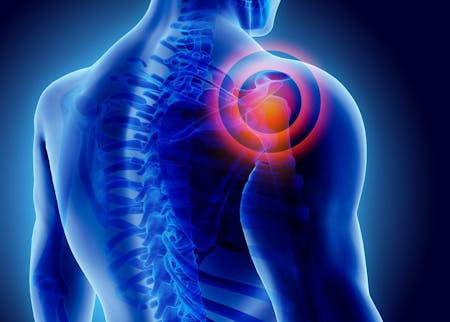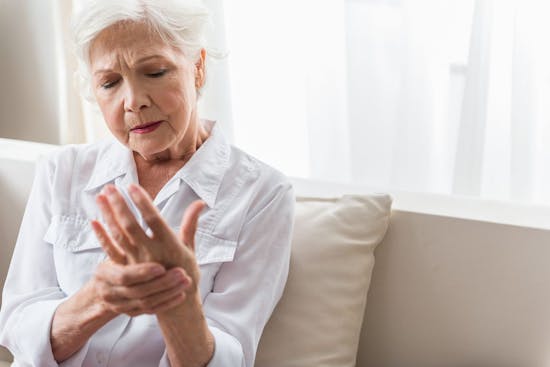-
Joint Pain
Joint pain is discomfort or pain in any part of the body where two or more bones meet to form a joint including cartilage and bone within the joint or ligaments, tendons, muscles and bursae surrounding the joint. It is usually caused by damage resulting from normal wear and tear but can also be caused by an injury and sometimes disease.
Common conditions that cause joint pain include:
- Arthritis (Arthralgia) - Osteoarthritis (OA), Rheumatoid Arthritis (RA)
- Muscle Strain - over-stretching or tearing of a muscle
- Tendon Strain - over-stretching or tearing of a tendon (tissue connecting muscle to bone)
- Sprains - over-stretching or tearing of a ligament (band of tissues that connect two bones)
- Fibromyalgia - an autoimmune disorder causing widespread muscle pain and tenderness
- Bursitis - inflammation of the fluid-filled sacs that protect the joint
If you are suffering with any of the above-mentioned signs or symptoms, chances are, our physical therapists can help. Joint pain is a very common condition that we treat on a daily basis. One of the many treatment techniques we use for treating joint pain is called joint mobilization.
What is Joint Mobilization?
Joint mobilization is a manual therapy intervention that involves the application of targeted pressures or forces on a joint accompanied by skilled passive movement of the articular surfaces. This helps relieve joint pain as well as improving mobility and physical function (the ability to walk and move).
Types of Joint Mobilization We use a number of techniques to mobilize (move) joints in the body. These mobilization techniques often have specific names derived from the clinicians that created and successfully tested them on patients.
Examples of some techniques are:
- Instrument Assisted Soft Tissue Mobilization (IASTM)
- Mulligan Manual Therapy - mobilization with movement
- Neural Tension Mobilization – specialized techniques to move nerves
- Graded Mobilizations – low velocity movement techniques with various amplitudes
- Manipulation – high velocity, low amplitude thrust at or near the end-range of joint mobility
Joint Manipulation for the Spine
For people with back pain and stiffness, we use a specific type of mobilization called spinal manipulation (sometimes known as spinal manipulative therapy). This involves using our hands or a device to apply a controlled force to a joint in the spine. The amount of force applied depends on the form of manipulation used. The goal of the treatment is to relieve pain and improve physical functioning.
Side Effects and Risks
Reviews have concluded that spinal manipulation for back pain is relatively safe when performed by a trained and licensed practitioner. The most common side effects are generally minor and include feeling tired or experiencing temporary soreness.
Be sure to tell all of your health care providers about any complementary health treatments you receive. Give them a full picture of what you do to manage your health. This will help ensure coordinated and safe care.
Who can benefit from joint mobilization?
Any patient with joint stiffness or pain can benefit from joint mobilization. However, this technique is generally not used for patients with excessive joint flexibility or fused joints.
-
What is Arthritis?
Arthritis is inflammation of one or more of your joints that causes stiffness, swelling and tenderness. There are more than 100 types of arthritis. So, symptoms can vary widely depending on what type of arthritis you have and how severe it is.
Two of the most common types of arthritis are osteoarthritis (OA) and rheumatoid arthritis (RA). They both involve the breakdown of cartilage, but the cause of the breakdown is different.
- Osteoarthritis is a disease that typically involves age-related wear and tear of the cartilage that slowly progresses over many years before joint damage begins. Although, infection or injury can speed up the natural breakdown of cartilage. An estimated 27 million Americans are affected by OA.
- Rheumatoid arthritis is a disease of the synovium that mistakenly invades and destroys joints in the body, which can eventually cause the destruction of the bone and cartilage inside the joint. Most people with RA start developing joint damage within 2 years. But, some people may start experiencing joint damage as early as 3 months after the onset of RA symptoms. Approximately 1.5 million U.S. adults have RA.
Who Can Develop Arthritis?
Arthritis is a very common condition that affects over 3 million Americans of all ages per year. Even children develop arthritis, including newborns. Genetic markers in your family history can increase your risk of developing arthritis.
Physical Therapy Can Help
Physical therapists (PTs) are experts in the art and science of the evaluation and treatment of human movement dysfunctions. We care for people of all ages and treat a variety of muscle, joint and neurological conditions.
Conditions we have successfully treated:
- Joint Pain
- Osteoarthritis
- Rheumatoid Arthritis
- Knee Arthritis
- Hip Arthritis
- Shoulder Arthritis
- Hand Arthritis
What are my treatment options?
- Drugs
- Epidural Injections
- Surgery
- Physical Therapy*
Advantages of Physical Therapy:
- No side effects.
- Cost-effective.
- Supported by clinical research*.
- Customized to treat the underlying cause.
Your Recovery Process:
- Recovery of Joint Motion
- Recovery of Strength
- Pain Relief
- Improved Function
- Independent Care
Components of Your Care:
- A thorough biomechanical evaluation.
- Extensive patient education.
- A customized treatment plan.
- Effective joint mobilization techniques to decrease joint stiffness.
- Pain-relieving modalities such as ice, heat, ultrasound or electrical stimulation.
- Targeted stretching for tight muscles.
- Progressive strength training.
- Balance and functional re-education.
Everyone is different. You may require one or two visits or an extended care plan over several weeks or months. If you’re ready for relief, and tired of “masking” your pain, treat the cause, not just the symptoms!
* Physical therapy techniques are recommended for arthritis of the knee, hip, shoulder, and hand. Physical Therapy 2005 85: 907-971; Physical Therapy 2004 84: 934-972.


